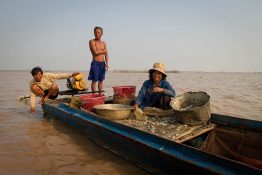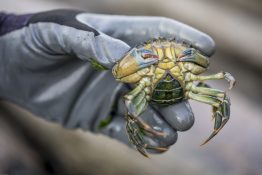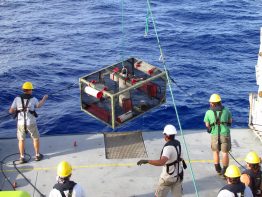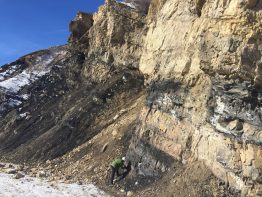Nearly 100 hydropower dams are planned for construction along the tributaries and main stem of the Mekong River’s 2,700-mile stretch. The river, one of the world’s largest, flows through Burma, China, Vietnam, Laos, Thailand and Cambodia. It is an economic engine for fishermen and a food source for millions of people worldwide. While the dams are expected to provide clean energy to the region, if not managed properly they also have the potential to offset natural river patterns, which would damage food production, supply and business.
Read more at UW Today »Preventing a crustacean invasion
Washington Sea Grant’s Emily Grason and its Crab Team volunteers are on a mission to protect the Salish Sea from one of the world’s worst invasive species — the European green crab.
Read more »There's a deeper fish in the sea
Meet the deepest fish in the ocean, a new species named the Mariana snailfish by an international team of researchers that discovered it. They’re small, translucent, bereft of scales — and highly adept at living where few other organisms can. The Mariana snailfish (Pseudoliparis swirei) thrives at depths of up to about 8,000 meters (26,200 feet) along the Mariana Trench near Guam.
Read more at UW Today »Salt pond in Antarctica, among the saltiest waters on Earth, is fed from beneath
At the base of the Transantarctic Mountains lies a geological oddity. Don Juan Pond is one of the saltiest bodies of water on the planet, filled with a dense, syrupy brine rich in calcium chloride that can remain liquid to minus 50 degrees Celsius, far below the freezing point of water. But the source of water and salt to this unusual pond remains a mystery — even as hints emerge that water in a similar form could exist on Mars.
Read more »Less life: Limited phosphorus recycling suppressed early Earth’s biosphere
The amount of biomass — life — in Earth’s ancient oceans may have been limited due to low recycling of the key nutrient phosphorus, according to new research by the University of Washington and the University of St. Andrews in Scotland. The research, published online Nov. 22 in the journal Science Advances, also comments on the role of volcanism in supporting Earth’s early biosphere — and may even apply to the search for life on other worlds.
Read more at UW Today »





